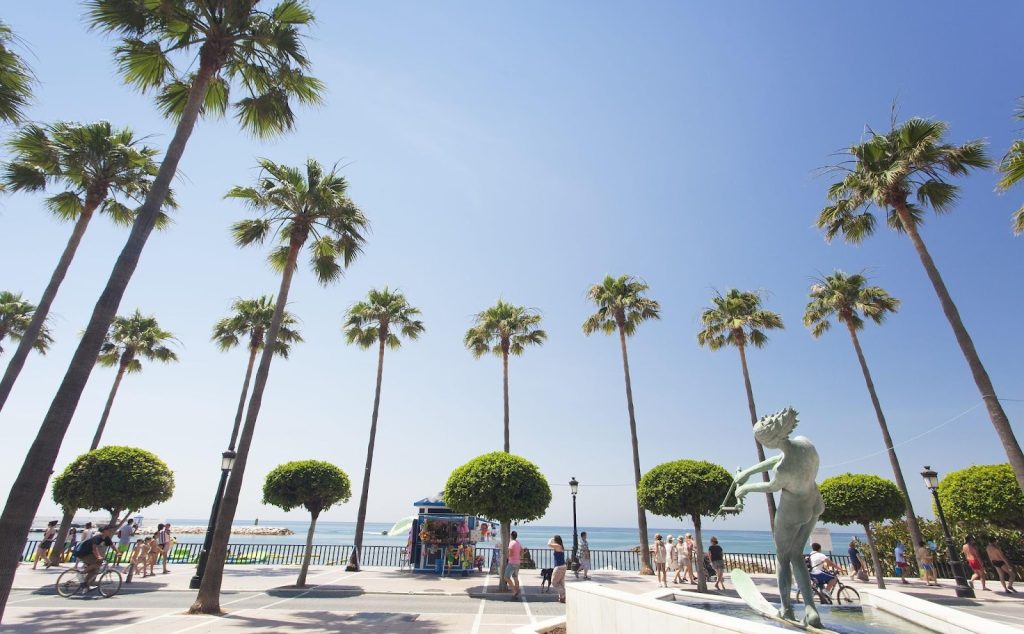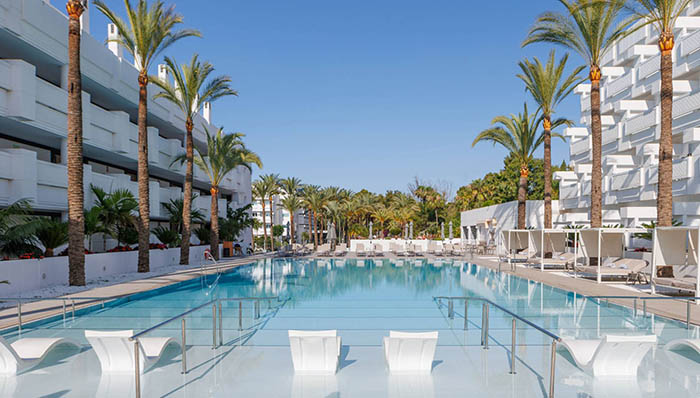Marbella’s promenade, the flow of its life
The Paseo de la Castellana in Madrid. Drottninggatan in Stockholm. The Grachtengordel canals in Amsterdam. Or the walk along the banks of the Thames between Tower Bridge and Westminster Bridge in London. Every city has a main thoroughfare that displays its most characteristic identity. And beyond big capitals, other smaller cities such as Marbella also enclose unique kilometers in our planet.
The main street of our city is Avenida Ricardo Soriano, the first in both traffic and commercial activity. On the other hand, the so-called Golden Mile marks the approximately four kilometres of the city’s most exclusive area, at the very heart of which the Alanda Marbella Hotel is located. However, it is a third thoroughfare that truly defines the spirit of this seaside paradise: the Marbella promenade.

In its more than 17 kilometres, Marbella’s promenade is one of the most visited and enjoyed areas by tourists and locals alike. Its origins date back to the mid 60’s, during the time of the city’s tourist and real estate boom, and it was during the mayoralty of Jesús Gil, from the 1990s onwards, when it underwent its greatest expansion. Nowadays, its route runs along the entire coastline of the town centre, and extends both to the east, reaching the wide Los Monteros beach, and to the west, reaching Guayaba Beach, between San Pedro de Alcántara and Guadalmina.
Overlooking Gibraltar and the Moroccan Rif mountain range, this extensive Mediterranean terrace stretches from the most natural outskirts to the most vibrant hearts of the town. From wooden paths between sand dunes, such as the section at El Pinillo beach, to lively areas surrounded by shops, bars, cafes, restaurants, street markets, amusements for children and beach clubs.
Marbella’s promenade also connects most of the city’s icons and attractions. Marbella’s promenade also connects most of the city’s icons and attractions. Puerto Banús and its 30-metre high La Victoria statue, popularly known as “The Russian”, stand out at the western end, while the Torre del Cable does so at the eastern end. Indeed, Torre del Cable is an abandoned maritime loading bay, a symbol of the historic mining economy of Marbella, which operated between 1957 and 1974 to ship iron from the defunct Peñoncillo mine.
Between these two points we can find other Marbella’s icons, such as the Venus statue, located on the circular breakwater of El Faro beach, or the famous wooden pier between Nagüeles beach and Casablanca beach, ideal for enjoying a beautiful panoramic view of the city just above the sea.

Moreover, Marbella’s promenade is one of the main social meeting points for its inhabitants, and is particularly popular as an open-air fitness area, especially for jogging, rollerblading and cycling. In fact, Marbella’s promenade has been part of the circuit of the famous Spain’s cycling tour for the past few years, and was its starting stretch in the 2015 edition. Apart from running, skating and cycling, the promenade also offers several free calisthenics and fitness machines, such as those located on Ancón beach, Fontanilla beach and La Venus beach.
Marbella’s promenade is also the gateway to its traditional chiringuitos (beach bars), which range from historic landmarks such as Victor’s Beach, opened in 1978, to more refined and succulent options such as Trocadero Arena. There you can try the espetos (sardine skewers) or the freshest “pescaíto frito” (fried fish), followed by a pleasant stroll along the route.

Thanks to its southerly orientation, Marbella’s promenade allows you to enjoy both sunrise and sunset from any of its points, being then the best times to discover the path. During sunset you can behold the beauty of an unique intercontinental view, as the setting sun outlines the figure of Gibraltar and North Africa while gilding Marbella’s landscape. It is also possible to experience the promenade at night, as it has a lighting system that extends along the entire urban stretch.
From the Alanda Marbella Hotel, Marbella’s promenade can be easily reached in a matter of minutes. Simply walk down to the beach via the Puente Romano alley, located just opposite the main entrance to the hotel, on the other side of the avenue. This access will lead you to the stretch of Nagüeles Beach, one of the quietest of the whole complex, perfect for strolling, relaxing and visiting the city’s most exclusive beach lounges. Thus, your stay at Alanda Marbella Hotel connects directly to one of the main attractions of the city and one of the most charming promenades in the world.


